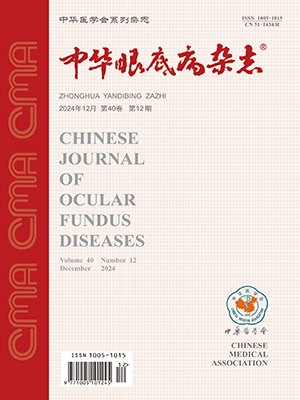| 1. |
Wu L, Fernandez-Loaiza P, Sauma J,et al.Classification of diabetic retinopathy and diabetic macular edema[J].World J Diabetes,2013,4(6):290-294. DOI:10.4239/wjd.v4.i6.290.
|
| 2. |
Hendrick AM, Gibson MV, Kulshreshtha A.Diabetic Retinopathy[J].Prim Care,2015,42(3):451-464. DOI:10.1016/j.pop.2015.05.005.
|
| 3. |
Hashmonay R, Parikh S.Re: Korobelnik et al.: Intravitreal aflibercept for diabetic macular edema (Ophthalmology 2014;121:2247-54)[J].Ophthalmology,2015,122(6):37-38. DOI: 10.1016/j.ophtha.2014.09.041.
|
| 4. |
Aiello LM.Perspectives on diabetic retinopathy[J]. Am J Ophthalmol,2003,136(1):122-135.
|
| 5. |
Raul VM, Jeffrey L. Fundus fluorescence angiography and indocyanine green angiography[J]. Ophthalmology, 2014, 121(6):440-447.
|
| 6. |
Ha SO, Kim DY, Song CH, et al. Anaphylaxis caused by intravenous fluorescein: clinical characteristics and review of literature[J].Intern Emerg Med,, 2014, 9(3): 325-30. DOI:10.1016/j.ophtha.2013.09.002.
|
| 7. |
Lira RP, Olivera CL, Maroues MV, et al. Adverse reactions of fluorescein angiography: a prospective study[J].Arq Bras Oftalmol,2007, 70(4): 615-618.
|
| 8. |
Schwartz DM, Fingler J, Kim DY,et al.Phase-variance optical coherence tomography: a technique for noninvasive angiography[J].Ophthalmology,2014,121(1):180-187. DOI:10.1016/j.ophtha.2013.09.002.
|
| 9. |
Choi W, Mohler KJ, Potsaid B, et al. Choriocapillaris and choroidal microvasculature imaging with ultrahigh speed OCT angiography[J/OL]. PLoS One, 2013, 8(12): 81499[2013-12-11]. https://doi.org/10.1371/journal.pone.0081499.DOI:10.1371/journal.pone.0081499.
|
| 10. |
Jia Y, Tan O, Tokayer J,et al.Split-spectrum amplitude-decorrelation angiography with optical coherence tomography[J].Opt Express,2012,20(4):4710-4725. DOI:10.1364/OE.20.004710.
|
| 11. |
刘青,艾明.光学相干断层扫描血管成像技术在糖尿病视网膜病变中的应用[J].国际眼科杂志, 2016, 16(4): 678-680.DOI:10.3980/j.issn.1672-5123.2016.4.22.Liu Q, Ai M. Application of optical coherence tomography angiography for diabetic retinopathy[J].Int Eye Sci,2016, 16(4): 678-680.DOI:10.3980/j.issn.1672-5123.2016.4.22.
|
| 12. |
Ishibazawa A, Nagaoka T, Takahashi A,et al. Optical coherence tomography angiography in diabetic retinopathy: a prospective pilot study[J]. Am J Ophthalmol,2015, 160(1): 35-44. DOI: 10.1016/j.ajo.2015.04.021.
|
| 13. |
Bandello F, Corbelli E, Carnevali A,et al.Optical coherence tomography angiography of diabetic retinopathy[J].Dev Ophthalmol,2016,56:107-112. DOI: 10.1159/000442801.
|
| 14. |
中华医学会糖尿病学分会.中国2型糖尿病防治指南(2017版)[J].中华糖尿病杂志, 2018, 10(1):4-50. DOI: 10.3760/cma.j.issn.1674-5809.2018.01.003.Chinese Diabetes Society,Chinese Medical Association. Guidelines for the prevention and treatment of type 2 diabetes in China (2017)[J].Chin J Diabetes Mellitus,2018, 10(1):4-50.DOI: 10.3760/cma.j.issn.1674-5809.2018.01.003.
|
| 15. |
Lee B, Novais EA, Waheed NK,et al.En face doppler optical coherence tomography measurement of total retinal blood flow in diabetic retinopathy and diabetic macular edema[J].JAMA Ophthalmol, 2017,135(3):244-251. DOI:10.1001/jamaophthalmol.2016.5774.
|
| 16. |
Couturier A, Mane V, Bonnin S.et al.Capillary plexus anomalies in diabetic retinopathy on optical coherence tomography angiography[J]. Retina, 2015,35(11):2384-2391. DOI: 10.1097/IAE.0000000000000859.
|
| 17. |
de Carlo TE,Chin AT, Bonini Filho MA, et al. Detection of microvascular changes in eyes of patients with diabetes but not clinical diabetic retinopathy using optical coherence tomography angiography[J]. Retina, 2015, 35(11): 2364-2370.DOI:10.1097/IAE.0000000000000882.
|
| 18. |
Agemy SA, Scripsema NK, Shah CM, et al. Retinal vascular perfusion density mapping using optical coherence tomography angiography in normals and diabetic retinopathy patients[J]. Retina, 2015, 35(11): 2353-2363.DOI: 10.1097/IAE.0000000000000862.
|
| 19. |
Lee J, Rosen R. Optical coherence tomography angiography in diabetes[J].Curr Diab Rep,2016, 16(12):123.DOI: 10.1007/s11892-016-0811-x.
|
| 20. |
Durbin MK, An L, Shemonski ND,et al. Quantification of retinal microvascular density in optical coherence tomographic angiography images in diabetic retinopathy[J].JAMA Ophthalmol,2017, 135(4): 370-376. DOI: 10.1001/jamaophthalmol.2017.0080.
|
| 21. |
Witmer MT, Parlitsis G, Patel S,et al.Comparison of ultra-widefield fluorescein angiography with the Heidelberg Spectralis(®) noncontact ultra-widefield module versus the Optos(®) Optomap(®)[J]. Clin Ophthalmol,2013,7:389-394. DOI:10.2147/OPTH.S41731.
|
| 22. |
Jack J,Kanscki BB. Diabetic macular edema[M]//Jack J,Kanscki BB. Clinical ophthalmology: a systematic approach. 7 th ed.Edinburgh: Elsevier-Health,2015:550-552.
|




